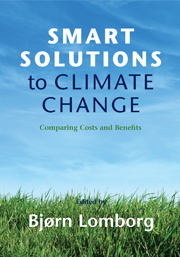Book contents
- Frontmatter
- Contents
- List of figures
- List of tables
- List of contributors
- Acknowledgments
- List of abbreviations and acronyms
- Introduction
- PART I THE SOLUTIONS
- 1 Climate Engineering
- 2 Carbon Dioxide Mitigation
- 3 Forestry Carbon Sequestration
- 4 Black Carbon Mitigation
- 5 Methane Mitigation
- 6 Market- and Policy-Driven Adaptation
- 7 Technology-Led Climate Policy
- 8 Technology Transfer
- PART II RANKING THE OPPORTUNITIES
- Conclusion
- Index
- References
8 - Technology Transfer
Published online by Cambridge University Press: 05 June 2012
- Frontmatter
- Contents
- List of figures
- List of tables
- List of contributors
- Acknowledgments
- List of abbreviations and acronyms
- Introduction
- PART I THE SOLUTIONS
- 1 Climate Engineering
- 2 Carbon Dioxide Mitigation
- 3 Forestry Carbon Sequestration
- 4 Black Carbon Mitigation
- 5 Methane Mitigation
- 6 Market- and Policy-Driven Adaptation
- 7 Technology-Led Climate Policy
- 8 Technology Transfer
- PART II RANKING THE OPPORTUNITIES
- Conclusion
- Index
- References
Summary
Introduction
Climate change is an ongoing challenge faced in the twenty-first century and beyond. Economic activities since the industrial revolution, mainly fossil fuel combustions and agriculture, have emitted huge amounts of greenhouse gases (GHGs) into the atmosphere. The anthropogenic GHG emission is the main source for measureable atmospheric temperature increases over past decades (IPCC 2007). Economists predict that global GHG emissions will keep increasing in the future, which will lead to further temperature rises. The climate that human beings have been used to for centuries will change drastically (IPCC 2007).
The detrimental impacts of climate change have long-lasting, sometimes irreversible, consequences. To alleviate these impacts, international cooperation on GHG emission reduction is urgently called for. The United Nations Framework Convention on Climate Change (UNFCCC), established in 1992, has been the grand institutional setting for potential international cooperation. Technology transfer (TT) as the means for international cooperation and a concrete approach to GHG mitigation have been at the center of policy debates and at the negotiation table.
The international community has recognized the vital importance of TT in coping with climate change. Without TT, “it may be difficult to achieve emission reduction at a significant scale” (IPCC 2007). TT should be a key component of any effective GHG mitigation strategies, therefore comprehensive studies of TT issues are crucial to GHG mitigation policy designs and implementations.
- Type
- Chapter
- Information
- Smart Solutions to Climate ChangeComparing Costs and Benefits, pp. 360 - 378Publisher: Cambridge University PressPrint publication year: 2010



